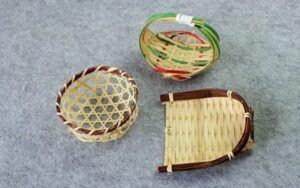Bamboo handicrafts are more than just artistic expressions; they represent a growing movement towards sustainable living and environmentally friendly practices. This article explores the diverse world of bamboo handicrafts, their benefits, and how they are changing the landscape of artisan crafts.

1. What Are Bamboo Handicrafts?
Bamboo handicrafts are handmade products made primarily from bamboo, a versatile and sustainable material. These crafts can range from decorative items to functional pieces, showcasing the craftsmanship of artisans worldwide.
2. The Importance of Sustainability
Bamboo is one of the fastest-growing plants globally, making it an ideal choice for eco-friendly crafts. Its rapid growth and renewability contribute to a lower carbon footprint compared to traditional wood.
3. Cultural Significance of Bamboo Crafts
Many cultures, especially in Asia, have a rich history of using bamboo in daily life. From traditional homes to festival decorations, bamboo plays an essential role in various cultural practices.
4. Types of Bamboo Crafts
4.1 Baskets and Weaving
Bamboo baskets are a staple in many communities, providing storage and carrying solutions. The intricate weaving techniques highlight artisans’ skills and creativity.
4.2 Furniture
Bamboo furniture has gained popularity due to its lightweight yet sturdy nature. Tables, chairs, and benches made from bamboo are both stylish and functional.
4.3 Home Decor
From wall hangings to decorative sculptures, bamboo is used in various home décor items, adding a touch of nature to living spaces.
4.4 Kitchenware
Bamboo kitchenware, such as cutting boards, utensils, and bowls, is not only eco-friendly but also adds a rustic charm to kitchens.

5. The Process of Making Bamboo Crafts
5.1 Harvesting Bamboo
Sustainable harvest practices are crucial to ensure the longevity of bamboo forests. Artisans often wait for the right season to harvest.
5.2 Treatment and Preparation
Before crafting, bamboo undergoes treatment to prevent pests and decay. This process involves soaking and drying the stalks.
5.3 Crafting Techniques
Different techniques, such as carving, weaving, and laminating, are employed to create unique bamboo products.
6. Benefits of Using Bamboo in Crafts
6.1 Durability
Bamboo is known for its strength and resilience, making it suitable for a variety of products, ensuring they last for years.
6.2 Aesthetic Appeal
The natural beauty of bamboo lends a distinct look to crafts, appealing to those who appreciate nature-inspired designs.
6.3 Lightweight Nature
Bamboo’s lightweight properties make it easy to handle and transport, improving the practicality of bamboo products.
7. The Role of Technology in Bamboo Crafting
With advancements in technology, artisans now have access to tools that enhance their crafting process while maintaining traditional methods.
8. Bamboo Crafts in the Global Market
8.1 Rising Popularity
Interest in bamboo handicrafts is growing globally, as more people seek sustainable and unique products.
8.2 E-commerce Platforms
Online platforms have made it easier for artisans to reach a broader audience, promoting bamboo crafts worldwide.
9. Challenges Faced by Bamboo Artisans
Despite its advantages, bamboo artisans face challenges such as competition from mass-produced items and the need for better marketing strategies.
10. How to Support Bamboo Craftsmanship
10.1 Buy Handcrafted Products
Support local artisans by purchasing handmade bamboo crafts, ensuring that your money goes directly to the craftspeople.
10.2 Spread Awareness
Share information about bamboo crafts on social media to raise awareness and encourage more people to appreciate these artworks.
11. DIY Bamboo Craft Projects
Engaging in DIY bamboo craft projects can be a fun way to explore this versatile material. Simple projects like making bamboo wind chimes or coasters can spark creativity.
12. Eco-Friendly Practices in Bamboo Crafting
Artisans are increasingly adopting eco-friendly practices, such as using non-toxic finishes and sustainable packaging methods.
13. Workshops and Training Programs
Numerous workshops and training programs help new artisans learn the skills needed to create bamboo crafts, promoting the craft’s future.
14. The Future of Bamboo Handicrafts
14.1 Innovation in Design
As consumer preferences evolve, innovative designs integrating bamboo with other materials are becoming popular.
14.2 Growing Market Trends
The demand for eco-friendly products is on the rise, positioning bamboo handicrafts favorably in future markets.
15. Conclusion: Embracing Bamboo Handicrafts
Bamboo handicrafts symbolize a perfect blend of art and sustainability. By choosing bamboo products, consumers can contribute to a more eco-friendly world while supporting artisans who dedicate their lives to preserving traditional crafts.

Leave a Reply